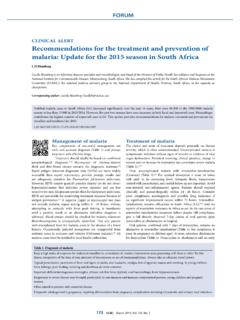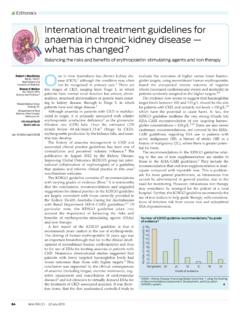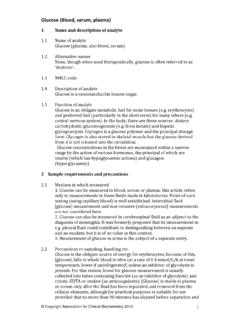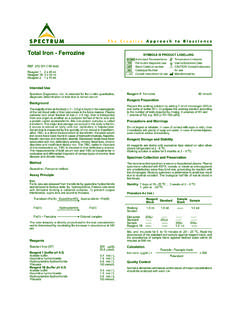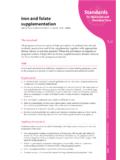Transcription of Haemoglobin concentrations for the diagnosis of …
1 Anaemia is a condition in which the number of red blood cells (and consequently their oxygen-carrying capacity) is insufficient to meet the body s physiologic needs. Specific physiologic needs vary with a person s age, gender, residential elevation above sea level (altitude), smoking behaviour, and different stages of pregnancy. Iron deficiency is thought to be the most common cause of anaemia globally, but other nutritional deficiencies (including folate, vitamin B12 and vitamin A), acute and chronic inflammation, parasitic infections, and inherited or acquired disorders that affect Haemoglobin synthesis, red blood cell production or red blood cell survival, can all cause anaemia. Haemoglobin concentration alone cannot be used to diagnose iron deficiency. However, the concentration of Haemoglobin should be measured, even though not all anaemia is caused by iron deficiency.
2 The prevalence of anaemia is an important health indicator and when it is used with other measurements of iron status the Haemoglobin concentration can provide information about the severity of iron deficiency (1). Inside Background Scope and purpose This document aims to provide users of the Vitamin and Mineral Nutrition Information System (VMNIS) with information about the use of Haemoglobin concentration for diagnosing anaemia. It is a compilation of current World Health Organization (WHO) recommendations on the topic and summarizes the cut-offs for defining anaemia and its severity at the population level, as well as the chronology of their establishment. The use of the cut-off points derived from the referenced publications permits the identification of populations at greatest risk of anaemia and priority areas for action, especially when resources are limited.
3 They also facilitate the monitoring and assessment of progress towards international goals of preventing and controlling iron deficiency and further provide the basis for advocacy for the prevention of anaemia. Haemoglobin concentrations for the diagnosis of anaemia and assessment of severity VMNIS | Vitamin and Mineral Nutrition Information System WHO/NMH/NHD/ Background 1 Description of technical consultation 2 Recommendations 3 Summary development Acknowledgements 5 Plans for update 5 References 6 4 Scope and purpose 1 VMNIS | 1 Haemoglobin concentrations for the diagnosis of anaemia and assessment of severity VMNIS | 2 Micronutrients Indicators Description of technical consultation This document compiles current WHO guidelines from five documents: Nutritional anaemias (2), is a report of a WHO Scientific Group that consisted of an international group of experts convened in Geneva, Switzerland from 13-17 March 1967.
4 The consultation was called three years after the start of a worldwide multi-country collaborative study in India, Israel, Mexico, Poland, South Africa, the United Kingdom, the United States of America, and Venezuela. The study investigated iron metabolism in pregnancy as well as the role of hookworm in anaemia during pregnancy, and further tested the procedures for examining blood and serum. The 1967 consultation reviewed overall progress of these studies and also discussed nutritional requirements of iron, folate, and vitamin B12. Preventing and controlling anaemia through primary health care (3) was published after a May 1987 meeting of the International Nutritional Anaemia Consultative Group (INACG) in Quito, Ecuador. This publication aims to help health administrators and programme managers to develop and implement suitable strategies for preventing and controlling iron deficiency anaemia.
5 It also considers some of the practical aspects of integrating primary care at various levels of organization learnt from the JNSP (WHO/UNICEF Joint Nutrition Support Programme), which was active in 18 countries at that time. The management of nutrition in major emergencies (4) was published by WHO in response to the World Declaration and Plan for Action in Nutrition (5) that urged governments to provide sustainable assistance to refugees, displaced and war-affected populations where high rates of malnutrition and micronutrient deficiencies occur. Iron deficiency anaemia: assessment, prevention and control, a guide for programme managers (6), a document published in 2001, is mainly based on a consultation organized by WHO, UNICEF, and the United Nations University (UNU) held in Geneva, Switzerland, 6-10 December 1993.
6 The purpose of this consultation was to provide scientists and national authorities a timely and authoritative review of iron deficiency anaemia, and also to help managers of national micronutrient malnutrition prevention and control programmes to identify effective measures for fighting iron deficiency anaemia. The conclusions of the consultation were complemented with additional scientific literature that appeared before 2000. Assessing the iron status of populations (1) is the report of a joint WHO and US Centers for Disease Control and Prevention (CDC) Technical Consultation held in Geneva, Switzerland, 6-8 April 2004, with the participation of 34 experts. With the ultimate goal of planning effective interventions to combat both iron deficiency and anaemia, the objectives of the Consultation were to review the indicators currently available to assess iron status, to select the best indicators for assessing the iron status of populations, to select the best indicators to evaluate the impact of interventions to control iron deficiency in populations, and to identify priorities for research related to assessing the iron status of populations.
7 This Consultation was preceded by a short WHO/CDC working group meeting held in January 2004 to review the literature on indicators of iron status and to select indicators for discussion. In April 2004, the Consultation was provided with literature reviews on indicators of iron status, including red blood cell (RBC) parameters, ferritin, free erythrocyte protoporphyrin, serum and plasma iron, total iron binding capacity, transferrin saturation and serum transferrin receptor as well as a review on the interpretation of indicators of iron status during an acute phase response. These four reviews are available in the second edition, published in 2007. Haemoglobin concentrations for the diagnosis of anaemia and assessment of severity VMNIS | 3 Micronutrients Indicators Table 1 Haemoglobin levels to diagnose anaemia at sea level (g/l) The anaemia cut-offs presented in Table 1 were published in 1968 by a WHO study group on nutritional anaemias (2), while the cut-offs defining mild, moderate and severe anaemia were first presented in the 1989 guide Preventing and controlling anaemia through primary health care (3) and then modified for pregnant women, non-pregnant women, and children less than five years of age in The management of nutrition in major emergencies (4).
8 The overall anaemia cut-offs have been unchanged since 1968, with the exception that the original age group of children 5-14 years of age was split, and a cut-off of 5 g/l lower was applied to children 5-11 years of age to reflect findings among non-iron deficient children in the USA (6). Although these cut-offs were first published in the late 1960s, they have been included in numerous subsequent WHO publications (3,4,6) and were additionally validated by findings among participants in the Second National Health and Nutrition Examination Survey (NHANES II) who were unlikely to have iron deficiency based on a number of additional biochemical tests (7). The Haemoglobin cut-off of 110 g/l for pregnant women was first presented in the 1968 report along with results of the five studies mentioned previously.
9 In healthy, iron-sufficient women, Haemoglobin concentrations change dramatically during Recommendations Population Anaemia* Non -Anaemia* Milda Moderate Severe Children 6 - 59 months of age 110 or higher 100-109 70-99 lower than 70 Children 5 - 11 years of age 115 or higher 110-114 80-109 lower than 80 Children 12 - 14 years of age 120 or higher 110-119 80-109 lower than 80 Non-pregnant women (15 years of age and above) 120 or higher 110-119 80-109 lower than 80 Pregnant women 110 or higher 100-109 70-99 lower than 70 Men (15 years of age and above) 130 or higher 110-129 80-109 lower than 80 pregnancy to accommodate the increasing maternal blood volume and the iron needs of the fetus (3).
10 concentrations decline during the first trimester, reaching their lowest point in the second trimester, and begin to rise again in the third trimester. Currently, there are no WHO recommendations on the use of different Haemoglobin cut-off points for anaemia by trimester, but it is recognized that during the second trimester of pregnancy, Haemoglobin concentrations diminish approximately 5 g/l. Residential elevation above sea level and smoking are known to increase Haemoglobin concentrations (6). Consequently, the prevalence of anaemia may be underestimated in persons residing at high altitudes and among smokers if the standard anaemia cut-offs are applied. Table 2 presents the recommended adjustments to be made to the measured Haemoglobin concentration among persons living at altitudes higher than 1000 metres above sea level, and Table 3 presents these adjustments for smokers.










